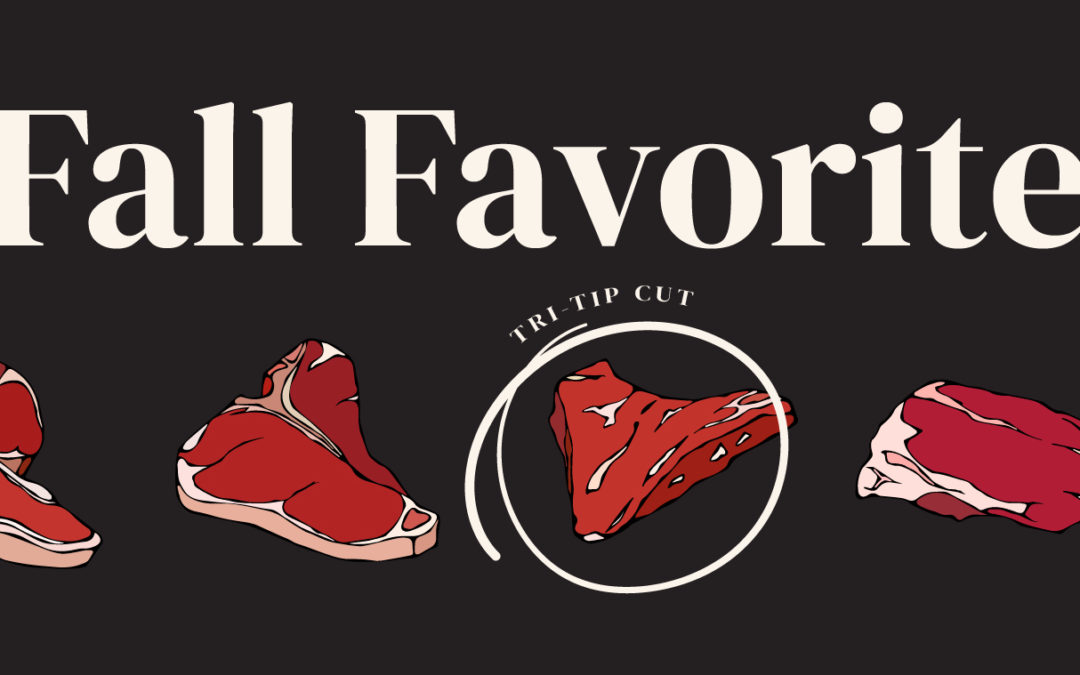While it’s fall in the calendar sense, there’s still a hint of summer in the air.
Warm days and cool nights don’t necessarily call for a change in your grilling habits, but if they do, we chose to highlight a cut of meat that you can bake or grill. Not only is it a shop favorite, but it’s super economical for a family meal or tailgate!
The cut? The humble tri-tip. First, we’ll learn a bit about the cut and then how to season, cook and serve this wonderful piece of beef.
What isn’t a tri-tip?
The easiest way to describe a tri-tip is to understand what it is commonly confused with.
It’s not a flap steak. While technically very close to the tri-tip in location (bottom sirloin), a flap steak is a piece of meat that better relates to a hanger or skirt steak. It has an accordion-like texture similar to a skirt steak and should be cooked in one piece. The hinged portion between thin sections of meat is a very soluble fat that flavors the meat as it cooks and is best used for fajita meat or steak tacos.
It's not a brisket. Tri-tips have a fat cap like a brisket but are much more tender and suitable for steak meals. A brisket has connective tissue that requires a low and slow cooking.
It’s not a flank. Flank steak is thin and stringy with a distinctive grain. It’s tender, but only if cooked properly and cut thinly.
It’s not a top sirloin cap or picanha. The cap of the top sirloin is tender and has fat, but it’s not as heavily grained and cooks more like a beef tenderloin. Its fat cap is not as dissolvable as a tri-tip fat cap and the cooking method does not lend itself to basting the meat like you would a low and slow cooked tri-tip. This cut is best cooked high and fast like a strip steak.
So, what is a tri-tip?
It’s a portion of bottom sirloin where three muscle groups come to a point. They weigh about 2.5 to 3lbs and have a distinct triangle shape to them, as each muscle group joins at the center of the roast. The thicker fat cap is essential for the baking or grilling method used, as it self-bastes the meat effectively while cooking.
How do you cook a tri-tip?
Prepping
The tri-tip can be either marinated or rubbed. Your choice here, but we have a winner picked out for you either way. Joe’s Marinade (sold in-store) was especially made for tri-tips! You can either marinate the tri-tip overnight in a zip lock bag or ask a Joe’s associate to vacuum seal your tri-tip in the marinade and then throw the vacuum-sealed bag in your fridge overnight. To rub a tri-tip, on the non-fat side, season generously with kosher salt, a light dusting of garlic powder and 10 to 15 generous cranks of fresh ground pepper. Rub the seasoning into the meat with some vigor.
If you choose to rub or marinate, the next step is critical. Before cooking, set the meat in its marinade or wrapped in plastic wrap on your counter for at least 3 hours. Meat brought closer to room temperature not only shortens your cooking time but also ensures you avoid the “grey/red two tone” color that comes with cooking cold meat.
The final step before cooking is an odd one. Before placing your roast on the grill or in the oven, grab a sticky note and draw an approximate outline of the meat and note the grain direction of the three different muscles. Good art is not important here but being able to distinguish the meat grain after cooking is! It’s critical that after cooking and resting you cut the meat against the grain!
Grilling
- Set up your grill for indirect heat (half on, half off, generally) and bring the temperature to about 350 degrees. We think a marinated tri-tip is the best for grilling. If you marinate, reserve some of the marinade in the bottle (tell us to leave 1/3 in the bottle if we vacuum seal), and place in a small glass dish for basting.
- Place your tri-tip, fat-side up first, on the “off” portion of your grill and cook, flipping every 5 minutes and basting with reserved marinade as you do.
- Cook the roast to a 120-degree internal temperature and then sear it on the “on” side of your grill (now turned to high) flipping it every 2 minutes until its internal temperature is 130-135 degrees (do NOT go higher).
- Remove the tri-tip from the grill and let it rest 10 minutes before cutting away the fat cap and then cutting the beef against the grain (Remember the picture you drew? Very glad to have it, huh?).
Total time including resting is about 30 minutes. You can slice it thin or into 1-inch portions for steak.
Baking
- Preheat your oven until it reaches 325 degrees.
- Place your roast in a roasting pan or baking dish fat-side up.
- Bake until the internal temperature reaches 130 degrees.
- Remove the roast from the oven and place on a cutting board to rest for 15 minutes.
- Cut the fat cap off and then cut against the grain to your desired thickness.
Total cook time is about 30 – 35 minutes.
Is it filet mignon? No, but it’s tasty as heck, tender and super budget friendly. Out west, they feel so guilt-free about the cost of this cut that they cook it past medium and smother it in BBQ sauce. If that’s your thing, go for it, but we at Joe’s are purists and believe full beef flavor is enjoyed better when it’s not covered up.
Happy fall! We will see you in October!

